skip to main |
skip to sidebar
 Though they started out this year with all odds against them, many of the tulips did make a good stand at providing an abbreviated late spring show. Dashes of bright color, amongst all the damaged daffodils and other victims of the recent freezes, they carried on in spite of it all ... I'm afraid these represent most of the better examples that managed to bloom this year ... our regular masses of yellow and red were pretty much decimated ... first by the cold and then by the recent heavy rains. And as the regular perennials start to make their presences known, it seems that the tulips were resigned to cede the show much more quickly this year, though through no fault of their own.
Though they started out this year with all odds against them, many of the tulips did make a good stand at providing an abbreviated late spring show. Dashes of bright color, amongst all the damaged daffodils and other victims of the recent freezes, they carried on in spite of it all ... I'm afraid these represent most of the better examples that managed to bloom this year ... our regular masses of yellow and red were pretty much decimated ... first by the cold and then by the recent heavy rains. And as the regular perennials start to make their presences known, it seems that the tulips were resigned to cede the show much more quickly this year, though through no fault of their own.
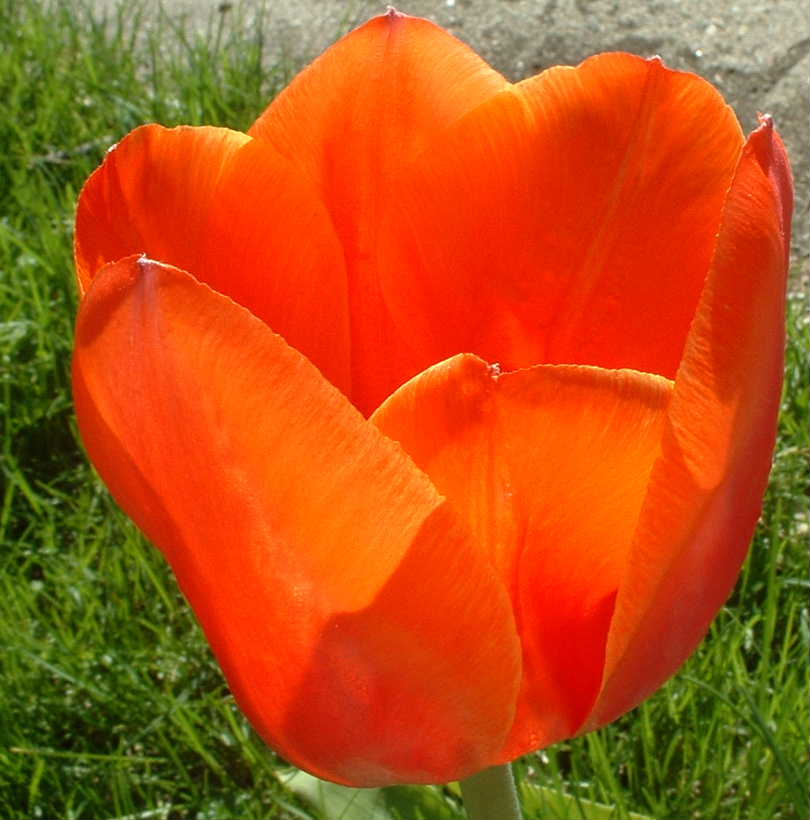 These two are from Darwin mixes that we have
These two are from Darwin mixes that we have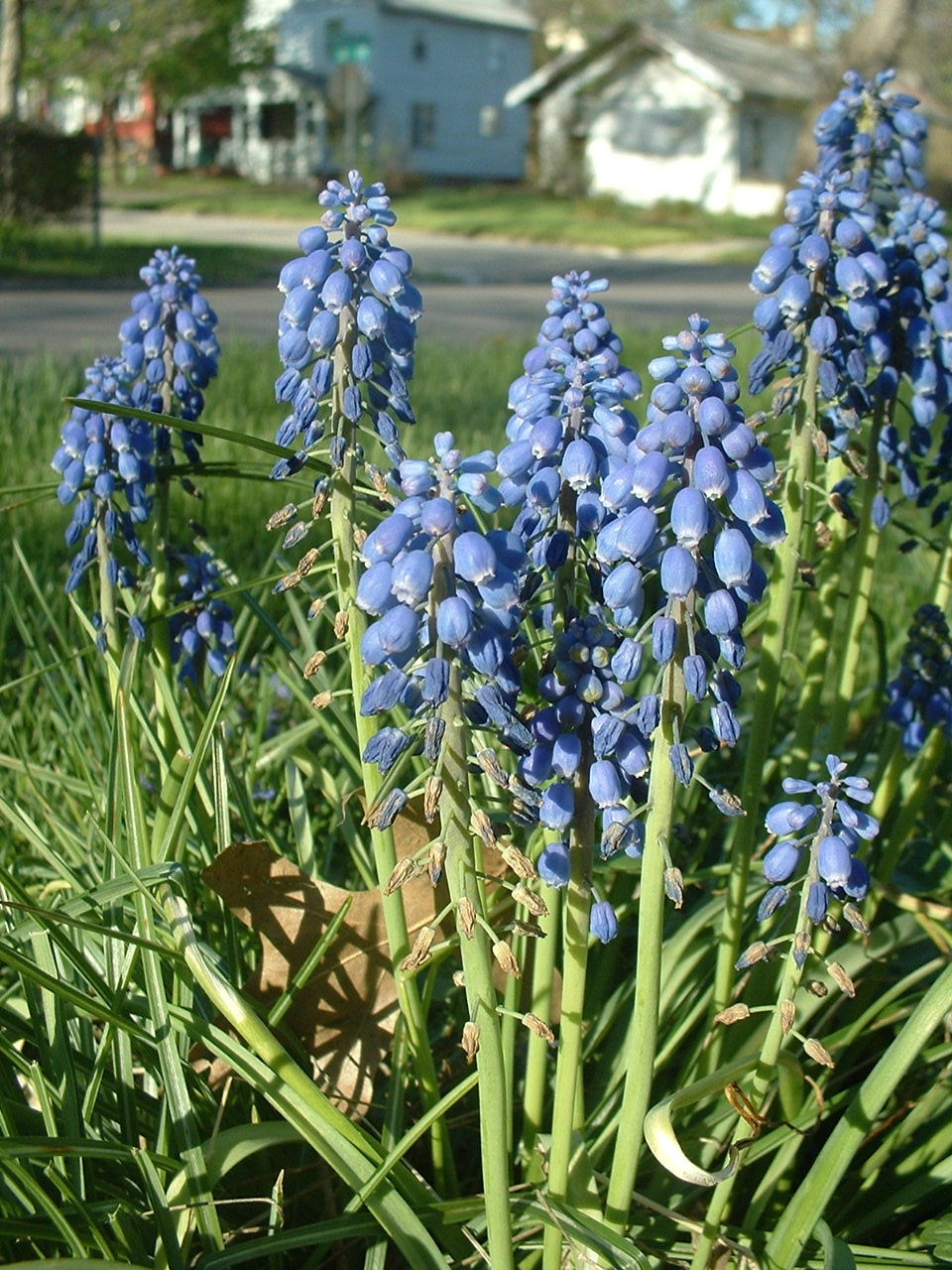 planted over the years ... the orange one has been around for at least five years and the yellow one (very close to an Olympic flame type) was planted two years ago during the big bulb planting fest. I'll refrain from my usual Darwins sermon ... just remember they're the best for naturalizing!
planted over the years ... the orange one has been around for at least five years and the yellow one (very close to an Olympic flame type) was planted two years ago during the big bulb planting fest. I'll refrain from my usual Darwins sermon ... just remember they're the best for naturalizing!
Finally (photo courtesy of Fernymoss), we've got a nice little stand of Muscari (Grape Hyacinth) along the walk ... also planted two years ago ... when I planted these, I alternated clumps of snow crocus (long since gone this year) with Muscari, as well as Scilla hispanica (Wood Hyacinth) all along the walk. Obviously I was really going for the blue, and as you'll see soon (when they bloom), the Scilla really carry on the show once the Muscari have packed it up for the season.
All three species of bulbs are great naturalizers, and my intent was that eventually the whole edge along the walk would be populated richly every early spring ... from a procession of crocus ... to Muscari and on to the Scilla providing at least two month's worth of changing blue hues. Of course, this year, everything is at least two weeks behind and these Muscari should have long since departed the scene ... but at least they weren't up very far when the freeze hit so they managed to bloom relatively unimpeded this year. And that's a good thing, since they've long been one of my favorite spring bulbs ... Related to neither grapes nor hyacinths, whatever we call them, they clearly deserve their place in anyone's garden ... especially along with tulips who they complement so well.
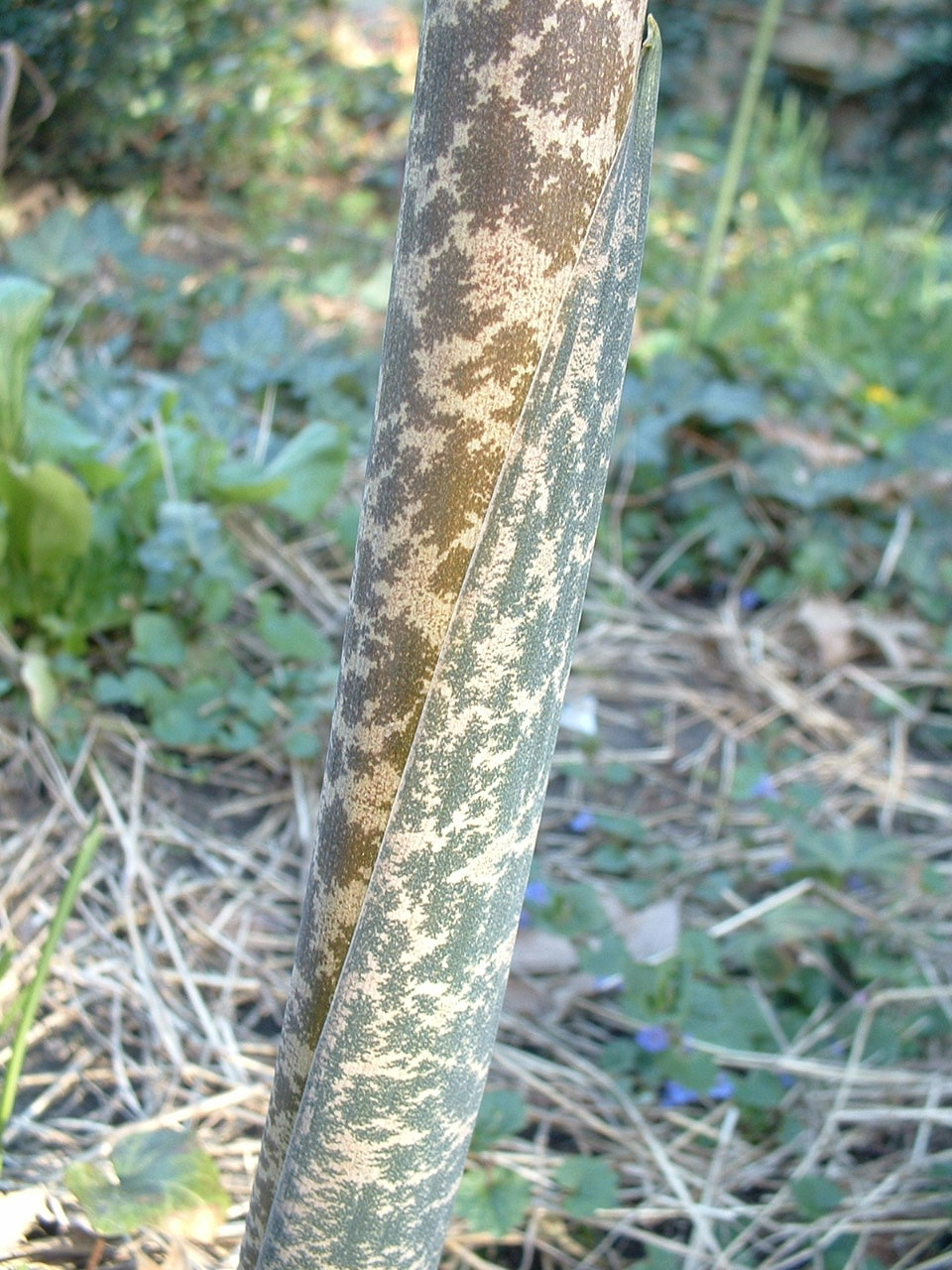 I thought I'd just pop up a sneak preview of a plant I'll be highlighting in the coming weeks ... so here it is! Obviously this is a detail of the stalk, but Fernymoss thought it would make an interesting subject, and after seeing the resulting photo, I really had to agree. Though it may resemble somewhat snakeskin, rest assured it truly is a member of flora rather than fauna ...
I thought I'd just pop up a sneak preview of a plant I'll be highlighting in the coming weeks ... so here it is! Obviously this is a detail of the stalk, but Fernymoss thought it would make an interesting subject, and after seeing the resulting photo, I really had to agree. Though it may resemble somewhat snakeskin, rest assured it truly is a member of flora rather than fauna ...
Anyone want to venture a guess as to what this is? (Olivia, no fair spilling the beans, ok?) I will say that it is one of the more exotic plants we have planted in recent years, and that's all I'll say for now, other than you will be seeing more of this plant as it progresses in the next few weeks!
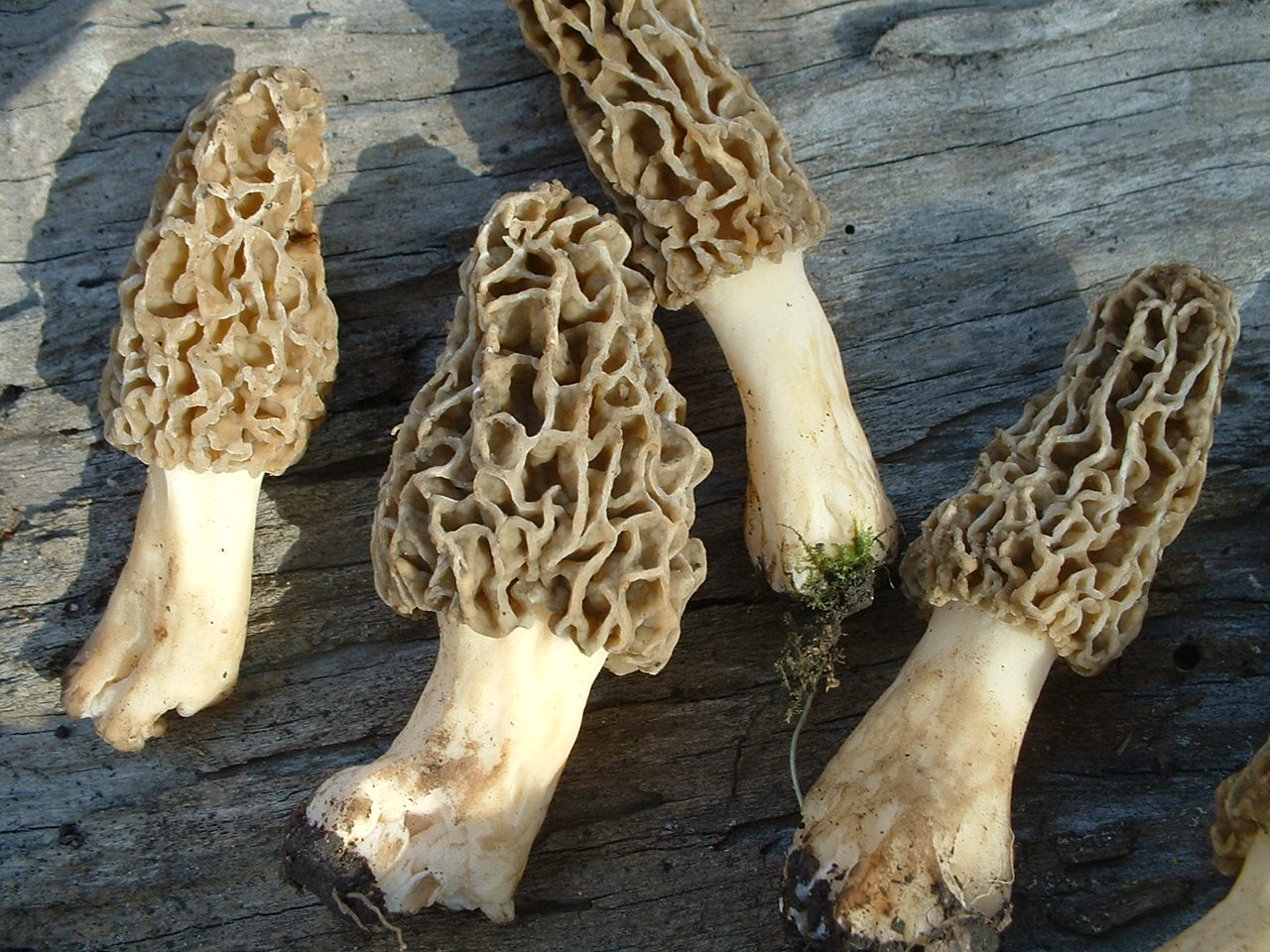 Here in Iowa, there's nothing quite like the Morel season in late April, early May ... depending on the year, they might be plentiful or they might be scarce ... but one thing is sure, they tend to appear in that in between time from early spring to early May. Prized by those who appreciate and savor their earthy flavors, they are a much sought commodity around these parts come this time of year. If you can find them at the local grocery store, you can expect to pay between $20-25 a pound for these short-lived delicacies. And if you're even luckier, you might just find them yourself on an afternoon trek through the timber on a warmish day in the mid to upper 70's. Though maddeningly elusive when hunting them in their habitat, Morels are an immensely rewarding find, and generally, once you've found one or two, you quickly see more ... But, great irony of hunting, the harder you look for them, the less likely you are to find them.
Here in Iowa, there's nothing quite like the Morel season in late April, early May ... depending on the year, they might be plentiful or they might be scarce ... but one thing is sure, they tend to appear in that in between time from early spring to early May. Prized by those who appreciate and savor their earthy flavors, they are a much sought commodity around these parts come this time of year. If you can find them at the local grocery store, you can expect to pay between $20-25 a pound for these short-lived delicacies. And if you're even luckier, you might just find them yourself on an afternoon trek through the timber on a warmish day in the mid to upper 70's. Though maddeningly elusive when hunting them in their habitat, Morels are an immensely rewarding find, and generally, once you've found one or two, you quickly see more ... But, great irony of hunting, the harder you look for them, the less likely you are to find them. 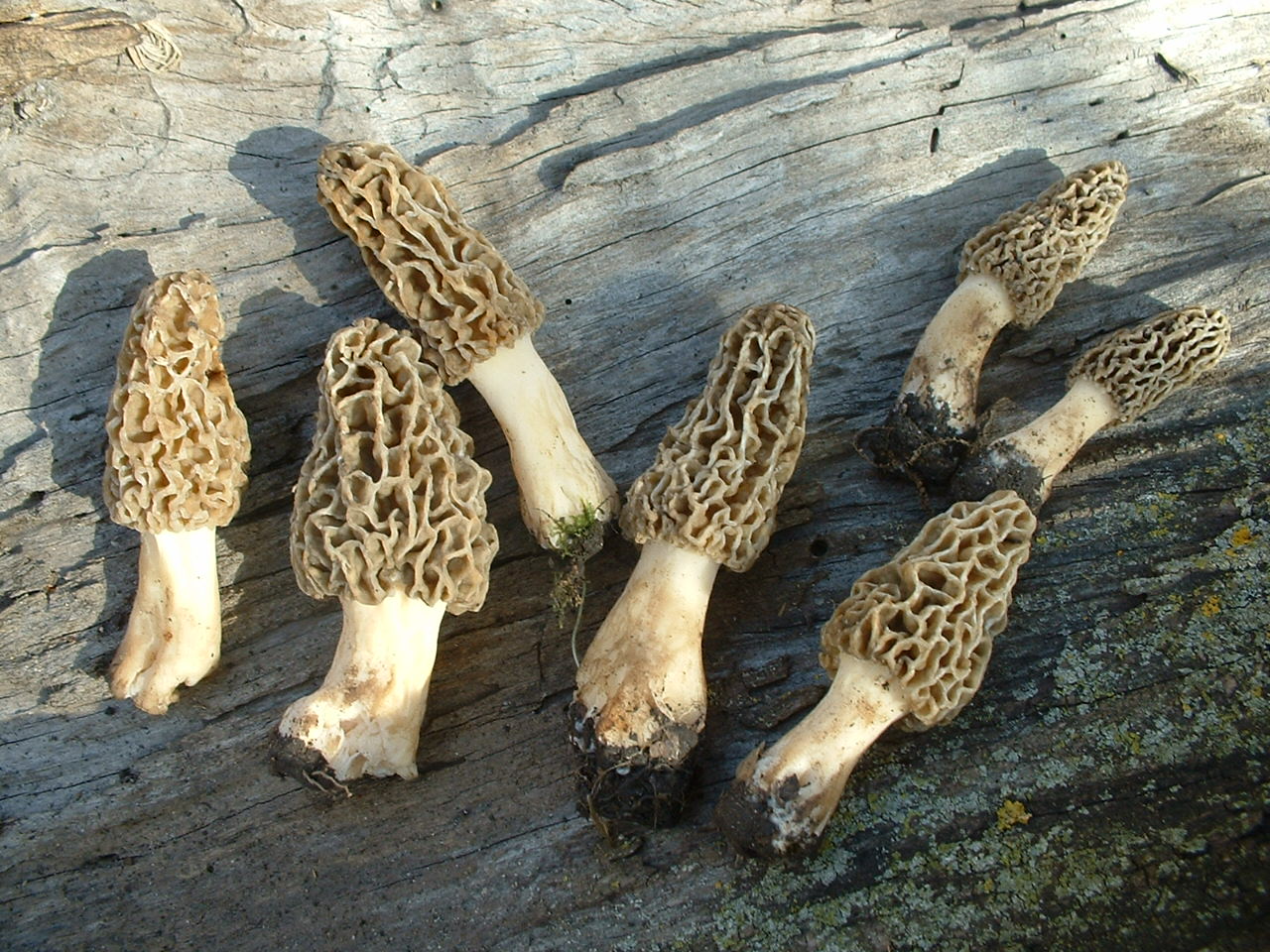
However, when you can successfully nab them (as C did today during an excursion in an undisclosed location), there's nothing quite like the excitement preceding their inevitable rendez-vous with the frying pan, some bread crumbs and a lot of butter.
Morels are legendary around these parts, and there are almost as many ways to eat them as there are recommendations to find them ... but if you're lucky enough to find them fresh and intact, there's little doubt that the true afficionados will soon be enjoying them as we will today. And by the time most may have read this post, they will likely be consumed .... Time to go hunting for more!
Update: 4-29-07 9:20 p.m.
What remains of these delectable morsels ... these photos ... They were damn tasty though! Wish Morel season came more often and lasted longer ... but that's what makes these brief visitors so prized ... they come quickly and leave as soon, not to return until the following year (if we're lucky).
 Just because I'm a space case and rarely remember birthdays (and assiduously avoid my own!), here's a nice bit of inner bits for my good gardening friend Olivia, who just recently avoided a birthday.
Just because I'm a space case and rarely remember birthdays (and assiduously avoid my own!), here's a nice bit of inner bits for my good gardening friend Olivia, who just recently avoided a birthday.
From the archives ... 30 July, 2006 (umm, my birthday, prime Leo I am) ... here's an interestingly crumpled looking shot of Hibiscus moscheutos "Kopper King" --- inner bits on full display! This is the plant in our back garden we've named "Olivia," in honor of our Canadian contingent in the gardening clan.
Kopper King is a magnificent Hibiscus Moscheutos hybrid with wonderful bronzy foliage reminiscent of a maple ... and the flowers speak for themselves! Amazing ... same easy upkeep as other Moscheutos varieties ... what could be easier?
Anyway ... sorry about spacing it out Olivia! Just think... it's warming up and soon the last of the winter funk will dissipate!
Happy Earth Day, despite the recent abnormal weather! 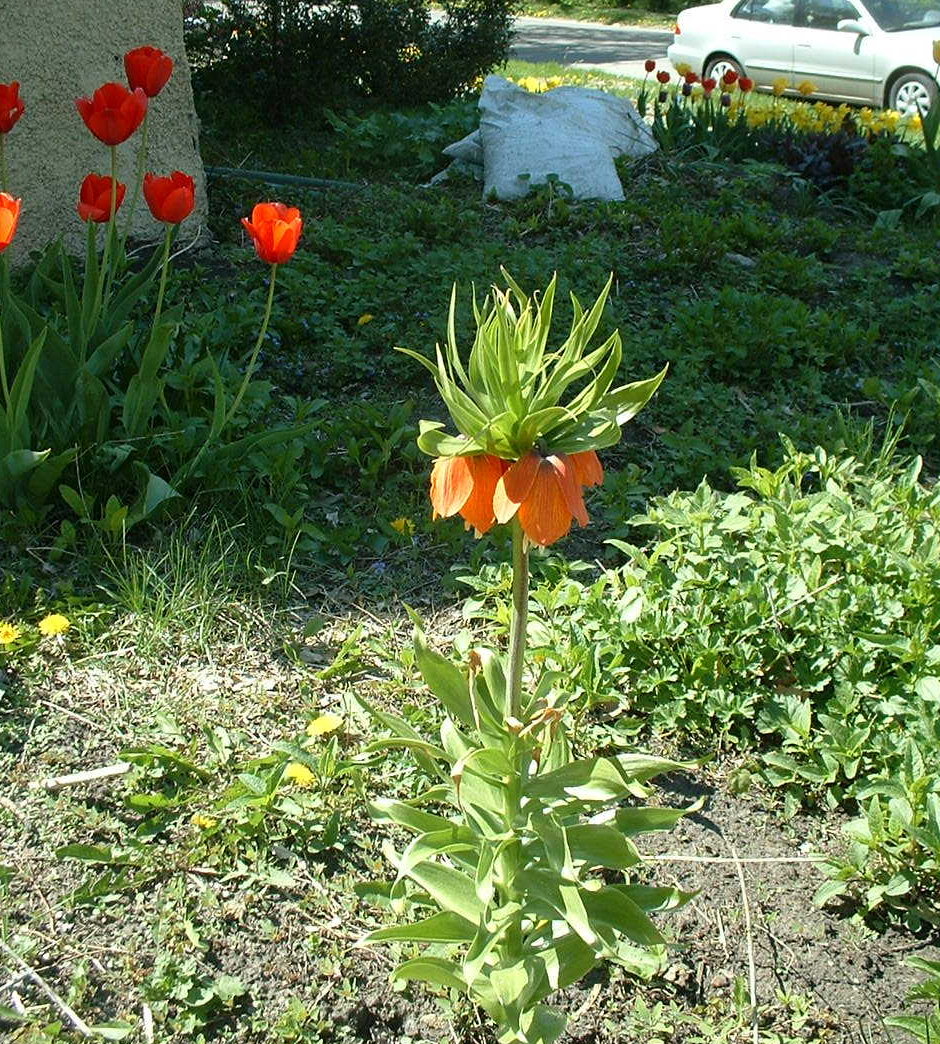
After a gloriously sunny, warm and windy day Saturday, today brought frequent thundershowers, wind and rain ... welcome rain, I might add, since I spent several hours out yesterday cleaning up about half of the front boulder beds. It was the perfect capper for all the flowers just getting going after a really cold last few weeks, just the thing to get them out from under their wraps (now removed thanks to my efforts yesterday) and ready to take on the season.
But, as you've no doubt seen me lament recently, the bulb extravaganza just was unable to equal last year's display ... even though most of the tulips are bravely blooming, they're stunted and fallen down, nowhere near their usual potential. And there are a few flowers just plain missing in action this year, notably among them, two of our recently acquired Fritillaria Imperialis species. This one is Rubra, a rich orange to red variety that starts out and finishes looking a bit like some very stalky kind of pineapple. The joys of Fritillarias are addictive ... we've just begun collecting them a couple of years ago, and already have several more species we hope to add next fall.  As the larger bulbs go, they're pretty easy to get established, though that two weeks of deep freezer weather seems to have put them down for this year. Although we may yet be surprised, we've pretty much given up on seeing any blooms from them. So these two shots are from exactly a year ago today ... 22 April, 2006, where they were enjoying near perfect blooming conditions.
As the larger bulbs go, they're pretty easy to get established, though that two weeks of deep freezer weather seems to have put them down for this year. Although we may yet be surprised, we've pretty much given up on seeing any blooms from them. So these two shots are from exactly a year ago today ... 22 April, 2006, where they were enjoying near perfect blooming conditions.
Though their bloom span is relatively short (about a week or so depending on the heat factor), they're hard to beat for sheer eye-catching power! No wonder they're commonly referred to as "Crown Imperials," because the majesty of the flowers and the sheer size of the plant (this one made it to about 24") just beg royal comparisons I guess. No matter, they're a great treat when they bloom and leave you wanting more ... in fact, the whole Fritillaria family has such a variety of sizes and blooming habits, (not to mention unusual coloration), that every serious gardener should consider making room for them in a prominent spot in the perennial border ... even though their appearance is brief each year, it is far from mundane.
For further information on the Fritillaria genus, here's the link to the very worthwhile Wikipedia entry on them.
 Here's the other species, Persica, that has not appeared yet this year, and perhaps won't .... One of the more unusual shades, Persica appears to range from deep, dusty purple to an almost chocolaty maroon color, depending highly on the light conditions in which you view it.
Here's the other species, Persica, that has not appeared yet this year, and perhaps won't .... One of the more unusual shades, Persica appears to range from deep, dusty purple to an almost chocolaty maroon color, depending highly on the light conditions in which you view it.
Like the Crown Imperials with which it often seems to be lumped in the bulb catalogues, it's one of the taller Fritillarias which, in its native habitat in Turkey, apparently grows on mountain slopes in relatively rocky terrain. And to honor that lineage, we've planted it relatively close to the signature "finger rock" near the front of the boulder perennial bed in front of the house. It put on quite the impressive show last year (in its first year blooming), but alas, we fear it won't be doing an encore this year. Our hope is that it is just taking a rest and will be back about a year from now, better than ever, and carrying on its impressive display ...
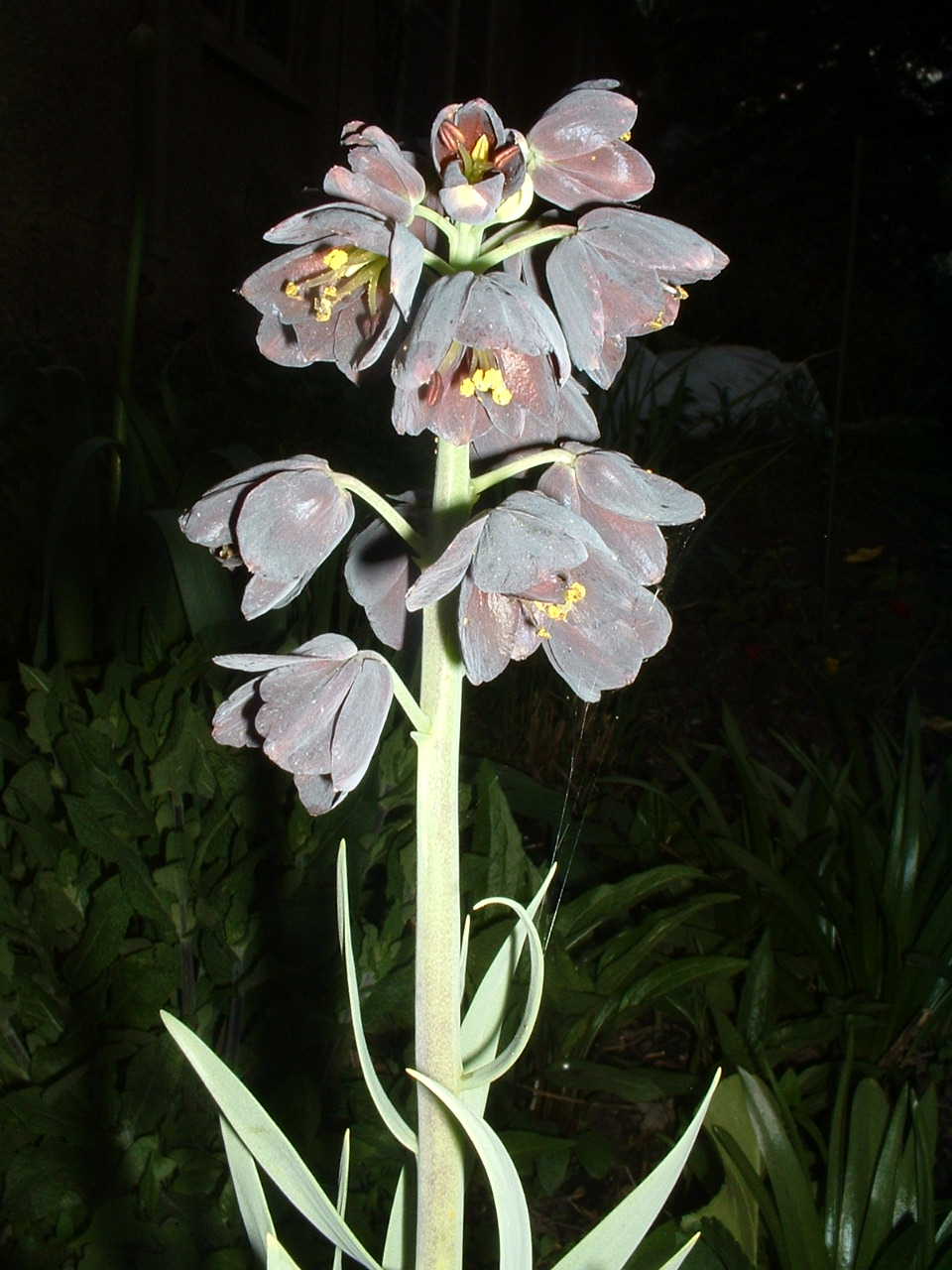 The first shot was taken in natural sun, showing its rich purplish hues. The second, taken with flash near dusk, gives an interesting detailed view of its inner bits, and shows off the "dusty" texture of the petals.... However you choose to view it, it counts as one of our new favorites among the spring bloomers. We're missing Persica this year, and should we yet be surprised, you'll see it here!
The first shot was taken in natural sun, showing its rich purplish hues. The second, taken with flash near dusk, gives an interesting detailed view of its inner bits, and shows off the "dusty" texture of the petals.... However you choose to view it, it counts as one of our new favorites among the spring bloomers. We're missing Persica this year, and should we yet be surprised, you'll see it here!
For very detailed species information and growing instructions, check out this link, since the Wikipedia link to it is mysteriously quite dead.
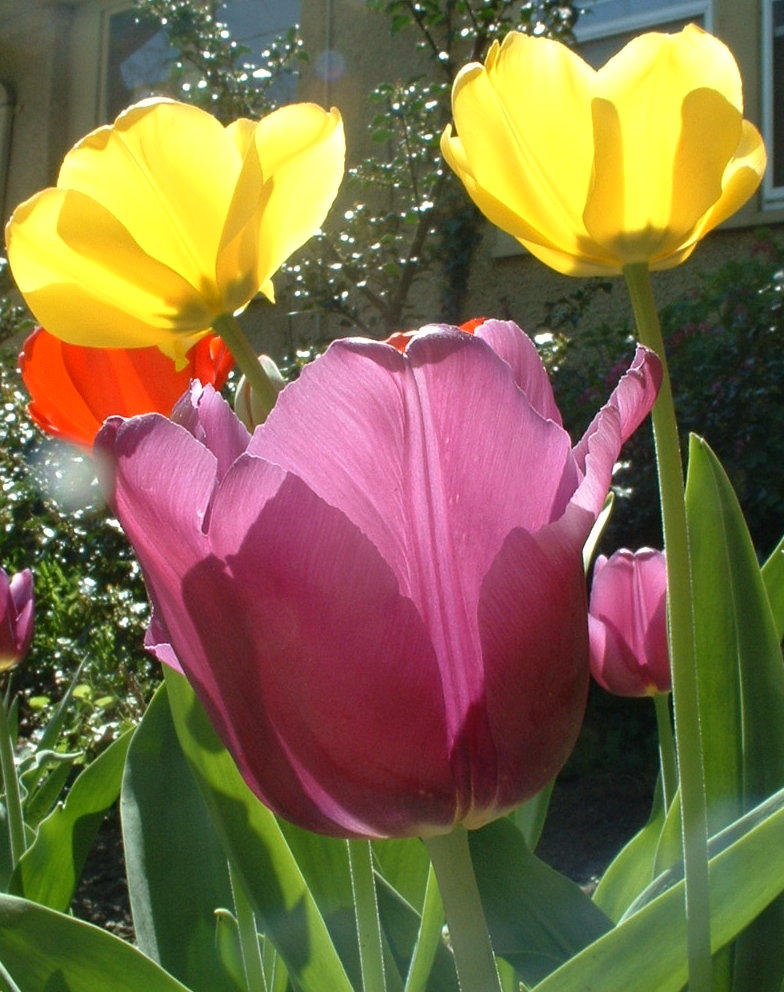 We'll just wrap up this particular phase of tulipidolatry for now with a nice, illuminated quartet of color (again from April, 2006), showing off the diverse range of truly outstanding shades the
We'll just wrap up this particular phase of tulipidolatry for now with a nice, illuminated quartet of color (again from April, 2006), showing off the diverse range of truly outstanding shades the
Darwins offer us ... If I haven't sold you by now on the many virtues of the Darwin varieties, I hope this last shot will really make you stop and take notice! They truly are remarkable flowers, and well worth the expenditure of effort it takes to get them going,
In the next few days I'll try to present some contrasting shots from this year, since it appears we will have some (albeit stunted) blooms after all ... not perfect by any means, but real miracles that they are going to be here at all this year!
So stop by again for those and some other surprises coming soon ... we have some exciting shots of a recently planted perennial about to burst forth in bloom in our woodland shade garden ...
... To be continued ...
And here we have the last few examples of Darwins to wind up our mini-series of tulip inner bits as captured last April, when the tulips were at their spring best ... And given the current terrain out there (as of today), these magnificent specimens were indeed in their prime blooming mode .... 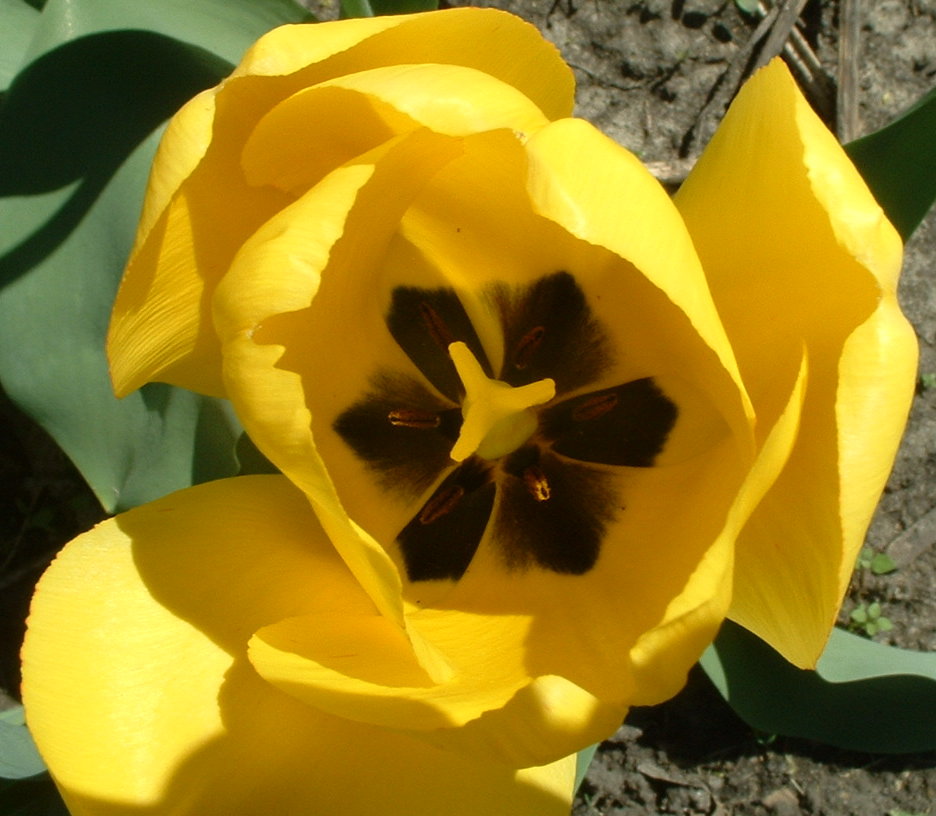
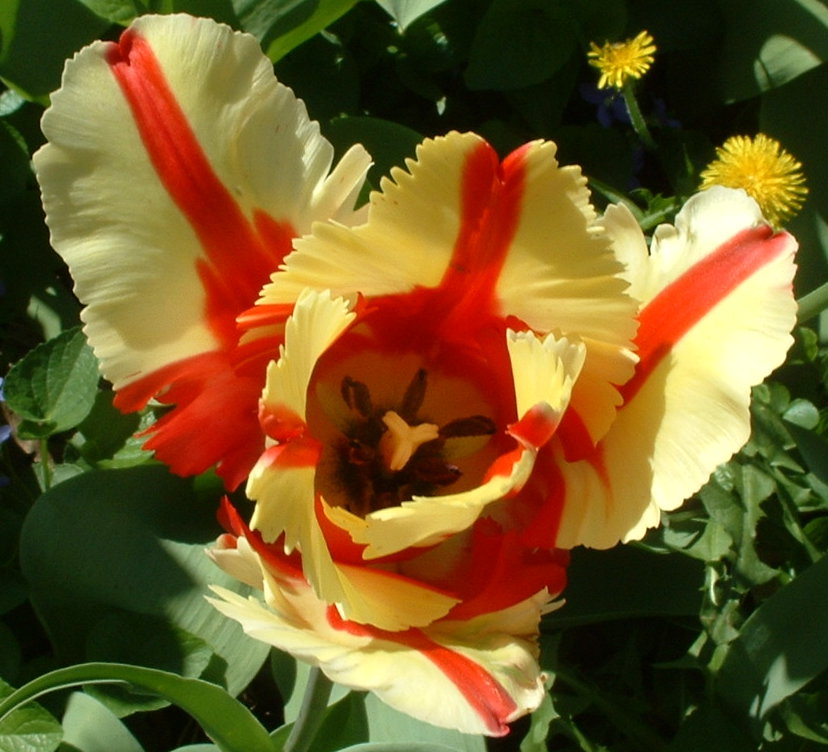 Though this year's tulips are trying valiantly to put on a show this year (see the bottom photo taken today), it's clearly not going to be anywhere near as show stopping as we achieved last year. So we'll have to content ourselves with some prime specimens from last April (2006) ... From the top we have an example of a simple (if that adjective could justifiably be applied to this flower!) basic yellow Darwin ... closely followed by one of the constantly dwindling Parrot Feather varieties that was planted among those first bulbs mentioned in a previous post ... and finally --just for Olivia, of course-- a dirty pink Darwin, one of a mix that I planted along the line of the sidewalk leading to the street.
Though this year's tulips are trying valiantly to put on a show this year (see the bottom photo taken today), it's clearly not going to be anywhere near as show stopping as we achieved last year. So we'll have to content ourselves with some prime specimens from last April (2006) ... From the top we have an example of a simple (if that adjective could justifiably be applied to this flower!) basic yellow Darwin ... closely followed by one of the constantly dwindling Parrot Feather varieties that was planted among those first bulbs mentioned in a previous post ... and finally --just for Olivia, of course-- a dirty pink Darwin, one of a mix that I planted along the line of the sidewalk leading to the street.
 Of course I'm especially partial to the yellows ... and I may be tempted to get a few more of the Parrot Feathers to replenish the stock, because though they are a fancy variety, the textures they exhibit are just far too fascinating to dismiss casually (as I tend to do with such cultivars). I particularly relish the "pinking shears" effect on the petals, not to mention the mysterious inner bits this particular tulip offers up ... just primed for an enterprising bee to explore and pollinate....
Of course I'm especially partial to the yellows ... and I may be tempted to get a few more of the Parrot Feathers to replenish the stock, because though they are a fancy variety, the textures they exhibit are just far too fascinating to dismiss casually (as I tend to do with such cultivars). I particularly relish the "pinking shears" effect on the petals, not to mention the mysterious inner bits this particular tulip offers up ... just primed for an enterprising bee to explore and pollinate....
And to my eye, the brilliant yellow (above) edged in inky black just screams bumblebee mimicry ... an inviting landing and collection pad just waiting to be used on a warm, sunny spring day, the likes of which we hope have finally arrived this year to banish the last of the winter woes we've had recently in the garden.
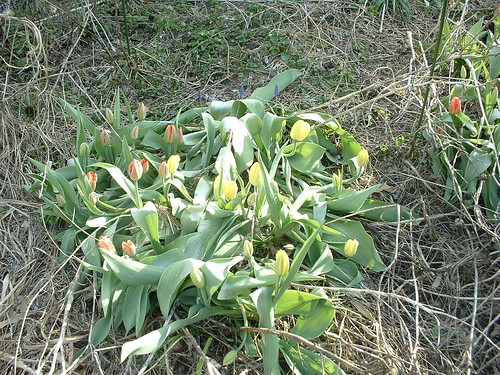 And, as sad testimony to the damage caused by our recent freezes, as well as the tenaciousness of these Darwins, I've included a shot of one of the masses of reds and yellows we have out in the main boulder bed. As you can see, they're doing their best to give us some blooms, but nothing close to what they've achieved in the past couple of years ... In any case, we plan on feeding them before they disappear for the season, in the hopes of better performance next year, weather permitting ....
And, as sad testimony to the damage caused by our recent freezes, as well as the tenaciousness of these Darwins, I've included a shot of one of the masses of reds and yellows we have out in the main boulder bed. As you can see, they're doing their best to give us some blooms, but nothing close to what they've achieved in the past couple of years ... In any case, we plan on feeding them before they disappear for the season, in the hopes of better performance next year, weather permitting ....
 As much as I praise and love the Darwin varieties, it's Tulipa, "Olympic Flame" that truly embodies for me the perfect combination of sun and fire ... and what better variety to liven up a sunny spring day! And that this particular strain belongs to the Darwins is only testament to its dazzling staying power ... These are some of the original tulips we first planted in the small bulb bed out front, our first foray into planting spring bulbs back in about 1999. Way back then, we quickly filled this bed with various varieties of tulips, fancy and otherwise, as well as daffodils, snowdrops, crocus and Fritillaria michaelovski specimens. Certain ones have come and gone (mostly the fancier tulips, who never seem to last over time ... as I keep preaching) and a few remain, the most faithful bloomers of which are these lovely examples. There are also a few remaining "Parrot Feather" tulips (more on them soon), but for the most part, those tulips whose pictures originally dazzled and seduced us (such as the "Blue Tulips" that turned out to be mauve!) have moved on and just quit appearing over time.
As much as I praise and love the Darwin varieties, it's Tulipa, "Olympic Flame" that truly embodies for me the perfect combination of sun and fire ... and what better variety to liven up a sunny spring day! And that this particular strain belongs to the Darwins is only testament to its dazzling staying power ... These are some of the original tulips we first planted in the small bulb bed out front, our first foray into planting spring bulbs back in about 1999. Way back then, we quickly filled this bed with various varieties of tulips, fancy and otherwise, as well as daffodils, snowdrops, crocus and Fritillaria michaelovski specimens. Certain ones have come and gone (mostly the fancier tulips, who never seem to last over time ... as I keep preaching) and a few remain, the most faithful bloomers of which are these lovely examples. There are also a few remaining "Parrot Feather" tulips (more on them soon), but for the most part, those tulips whose pictures originally dazzled and seduced us (such as the "Blue Tulips" that turned out to be mauve!) have moved on and just quit appearing over time.
 Ok, you can see this coming, so I'll say it just one more time ... if you're going to go to the trouble of planting tulips, make the effort worth it! Darwins are by far the best way to go for years of dependable color ... go ahead and plant those hybridized poodles of the tulip world for a few years of unusual splash if you want, but you'll always come back to the Darwins in the end. I guess it's kind of like the old saying ... you date the flashy ones, but will eventually marry the Darwins. Well, that is, if you have what's commonly referred to as a "lick of sense" in your head. Barring unforeseen catastrophes (such as our disastrous recent cold spell), they will return to reward you and delight you for years to come ... long after the last ruffled petalcoat has left town.
Ok, you can see this coming, so I'll say it just one more time ... if you're going to go to the trouble of planting tulips, make the effort worth it! Darwins are by far the best way to go for years of dependable color ... go ahead and plant those hybridized poodles of the tulip world for a few years of unusual splash if you want, but you'll always come back to the Darwins in the end. I guess it's kind of like the old saying ... you date the flashy ones, but will eventually marry the Darwins. Well, that is, if you have what's commonly referred to as a "lick of sense" in your head. Barring unforeseen catastrophes (such as our disastrous recent cold spell), they will return to reward you and delight you for years to come ... long after the last ruffled petalcoat has left town.
 These three shots were taken last year (4-22-06) on a gloriously sunny day, which really helps to show off the true range of fire you can get with Olympic Flame, thus justifying its rather high-falutin' moniker. All pretentions aside, they remain one of my all time favorite varieties ... so go ahead, click to enlarge them (or right click "view image" in Firefox) and get lost in the mesmerizing patterns of their striking inner bits!
These three shots were taken last year (4-22-06) on a gloriously sunny day, which really helps to show off the true range of fire you can get with Olympic Flame, thus justifying its rather high-falutin' moniker. All pretentions aside, they remain one of my all time favorite varieties ... so go ahead, click to enlarge them (or right click "view image" in Firefox) and get lost in the mesmerizing patterns of their striking inner bits!
I'll have some more different varieties up soon for you to compare with these so you can get a flavor of just how intricate the private regions of tulips can really be ... (Stay tuned, Olivia!)
And since this post was originally conceived of as a joint garden blog post, give a click here to see what Olivia has been doing with one of these!
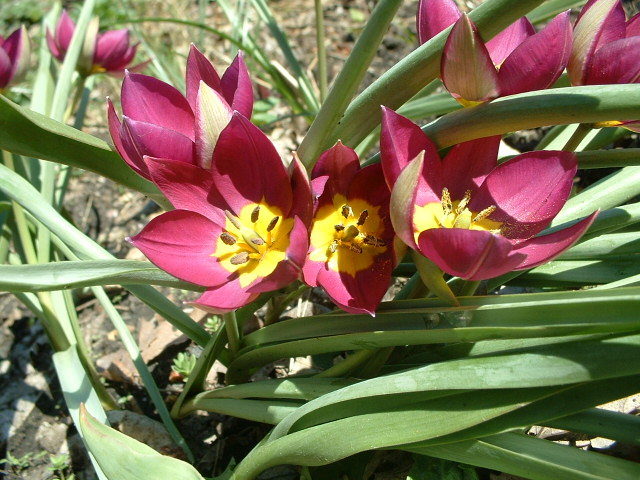 Tonight, I thought I'd just give a quick glimpse back to last year's more glorious bulb extravaganza with a shot of some of the Persian Pearl dwarf tulips I posted yesterday .... just as a point of comparison to allow you to judge just how much prettier they can be when they are blooming under more favorable conditions. Given the right weather, a nice sunny day and a less discouraged gardener, these little guys just positively shine! This shot was taken on April 12, 2006 (already much earlier than this year's "show") on their very first go round at blooming. Not bad for a group of tulips who just took up residence in this spot in the fall of 2005, eh?
Tonight, I thought I'd just give a quick glimpse back to last year's more glorious bulb extravaganza with a shot of some of the Persian Pearl dwarf tulips I posted yesterday .... just as a point of comparison to allow you to judge just how much prettier they can be when they are blooming under more favorable conditions. Given the right weather, a nice sunny day and a less discouraged gardener, these little guys just positively shine! This shot was taken on April 12, 2006 (already much earlier than this year's "show") on their very first go round at blooming. Not bad for a group of tulips who just took up residence in this spot in the fall of 2005, eh?
Note fully open centers of these flowers ... which Olivia (in comments on Monday) likened to the eager, open mouths of baby birds. I'd never thought of them quite that way before, but she definitely has a point there, n'est-ce pas?
 I couldn't resist sneaking just a wee preview of things to come soon from last year's archives! So here's a tulip, the likes of which we're unlikely to see this year in the garden ... one of our beloved Darwin oranges. I got a bit snoopy and penetrated the inner depths of this one just to see what kind of effect I could get, and I was rather delighted to see the results here!
I couldn't resist sneaking just a wee preview of things to come soon from last year's archives! So here's a tulip, the likes of which we're unlikely to see this year in the garden ... one of our beloved Darwin oranges. I got a bit snoopy and penetrated the inner depths of this one just to see what kind of effect I could get, and I was rather delighted to see the results here!
Recently Olivia suggested that I do a series of inner bits shots from various tulips, just to compare the variations in patterns they each exhibit, so this will be the first in a short ongoing project here. It is amazing to see how different they can be, depending on the hue and variety of tulip .... and those who know me constantly hear me preach, the Darwin varieties are by far the best of your basic tulips. They remain true to form for years and don't tend to poop out in a few years, nor do they tend to disappear or revert to previous forms much like the fancier varieties often do. And if any tulip justifies the "perennial bulb" moniker, it is surely the Darwins, since they bloom faithfully every year and even can spread over time (so I've read but not witnessed yet). If you're wanting to plant some resplendent tulips that you only have to really deal with once (planting!), and who come in amazing ranges of colors, then look into purchasing a good quantity and planting them in masses ... surrounded by Muscari ("Grape Hyacinth") or Scilla siberica OR Scilla hispanica ("Woodland Hyacinth") and you can't go wrong. As I like to remind my bulb intimidated friends ... all the hard work happens once, then you sit back and patiently await their arrival in the spring! And success with these beauties only breeds a fervent desire for more ... just ask us if you don't believe me on that one!
A couple of garden notes: Earlier, after I posted the other entries, I took another walk around to survey the garden and the inevitable devastation. The good news is that it looks as though the Columbines are going to recover and are putting on new growth ... the primroses are hanging in there and I think will bloom still, albeit late ... Woodland Hyacinths are springing up all over and thanks to their later emergence, don't seem to have suffered from the recent cold. BUT, the most exciting thing I discovered was that the two red Trilliums we first planted last year are up, budding out and getting ready to bloom! I'm really anxious to be able to share those with you, as you will be seeing them bloom for the first time, just like us ... The peonies have emerged as well, and though short still, they look unscathed. And though our iris out front were early to emerge, they seem to have weathered the cold pretty well and look to be working their way up to a great show this year ... as long as they don't immediately get beaten down by a hard rain, as was the case last year. I'll be really thrilled to get them up here when the time comes .... So, all in all, there may be hope yet for the garden, and for any dedicated gardener, there's always some way to find hope that things green and floriferous will find their ways to right the world, even if we humans are unable to do so.
And speaking of Irises ... Olivia has some lovely shots of molested blooms up now ... so hop on over and take a look at these luscious finds from the florist's!
 Or maybe I should say Courageous Hyacinths, given what they've had to endure these past couple of weeks! As I noted earlier, these are the only ones we've seen break ground so far, even though it is rather late for them at this point in spring, but it's been anything but a normal spring so far this year. These shots demonstrate how stressed even these valiant flowers are ... what looks blue should be a deep violet color (var. Peter Stuyvesant), and believe it or else, what appears pink should actually be a brilliant red! I just count myself lucky that they are even blooming, though they are only about half the size they should be, and look a bit washed out as you can see....
Or maybe I should say Courageous Hyacinths, given what they've had to endure these past couple of weeks! As I noted earlier, these are the only ones we've seen break ground so far, even though it is rather late for them at this point in spring, but it's been anything but a normal spring so far this year. These shots demonstrate how stressed even these valiant flowers are ... what looks blue should be a deep violet color (var. Peter Stuyvesant), and believe it or else, what appears pink should actually be a brilliant red! I just count myself lucky that they are even blooming, though they are only about half the size they should be, and look a bit washed out as you can see....
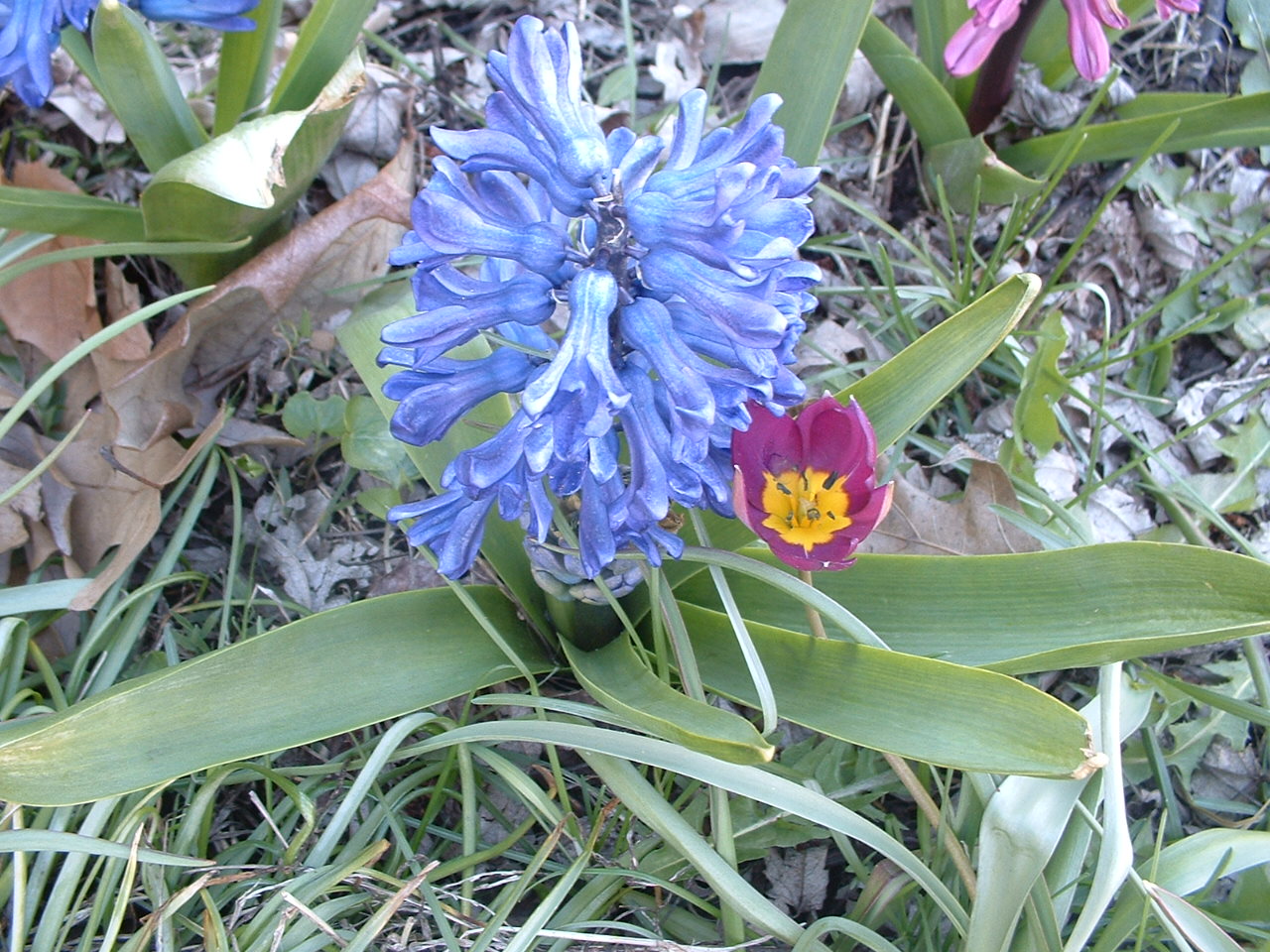 And you can see a friendly little companion Persian Pearl tulip snuggling in for the close up ... they're doing their best under bad circumstances, and I can only laud their courageous will to bloom despite all odds!
And you can see a friendly little companion Persian Pearl tulip snuggling in for the close up ... they're doing their best under bad circumstances, and I can only laud their courageous will to bloom despite all odds!
Well folks, those who've been listening patiently to my wailing and moaning the past few weeks know only too much about the recent very cold snap we've been having here. Right after I got going on posting the first spring bulbs, our weather took a very cold turn (lows in the low teens at night!), and what at first looked to be a banner year for the tulips, daffodils and other bulbs soon turned out to be a near washout. Or freeze-out, I should perhaps say... The front garden especially has taken a pretty bad hit and we're not sure how it's all going to turn out, despite the recent (e.g. yesterday and today!) upturn in the weather. I'm just not sure at this point how much we will be able to save, though the late emerging bulbs look to be coming out of this relatively unscathed.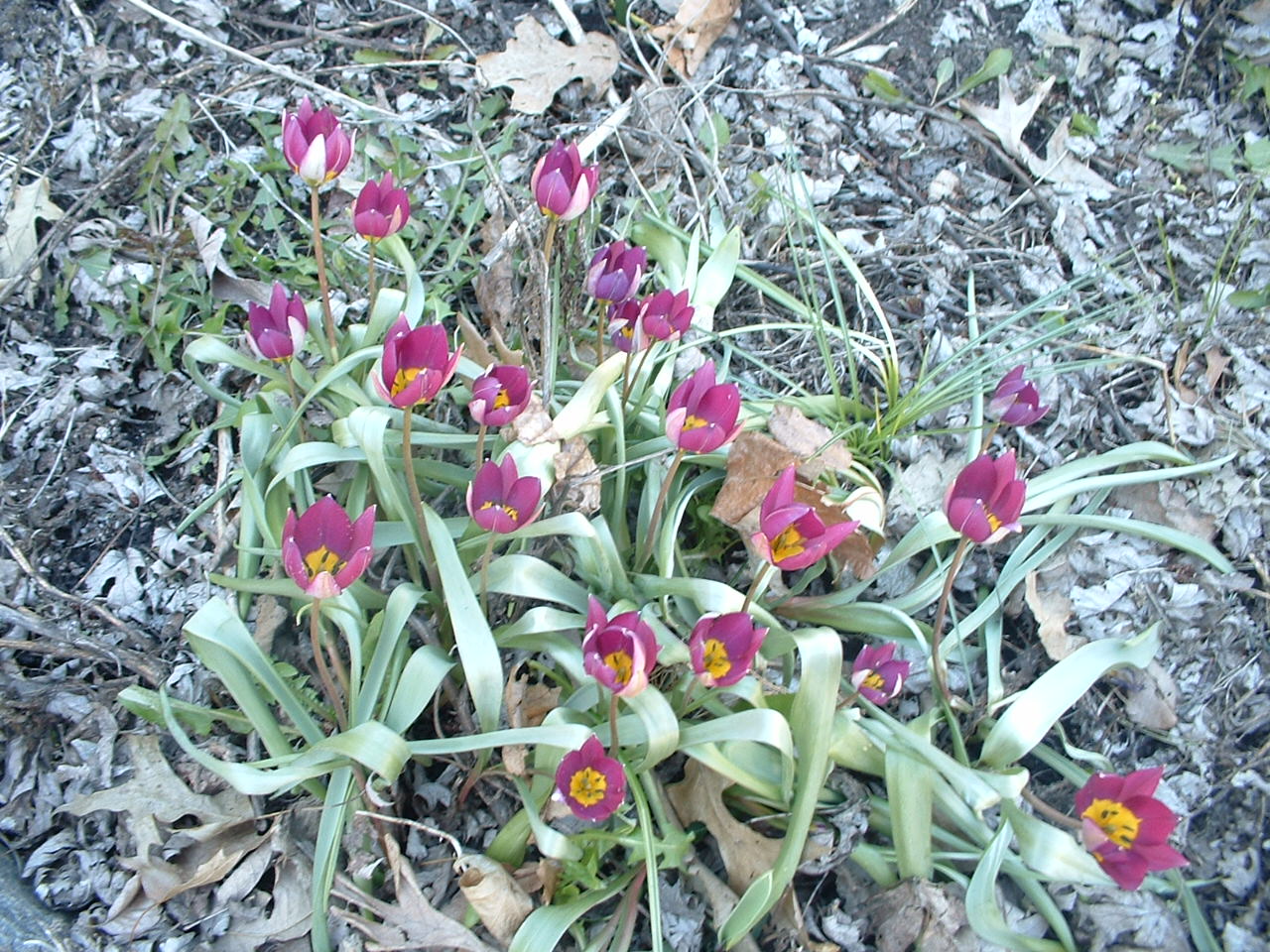
To wit ... our bleeding hearts were up about a foot before the record cold set in ... and now they look like spent, limp spaghetti. Same with the columbines .... even the sea holly is looking rather worse for wear, but I do think they will eventually pull out of it ... I hope. And, with the recent arrival of better weather, I hope to be able to report more positive news in the coming weeks.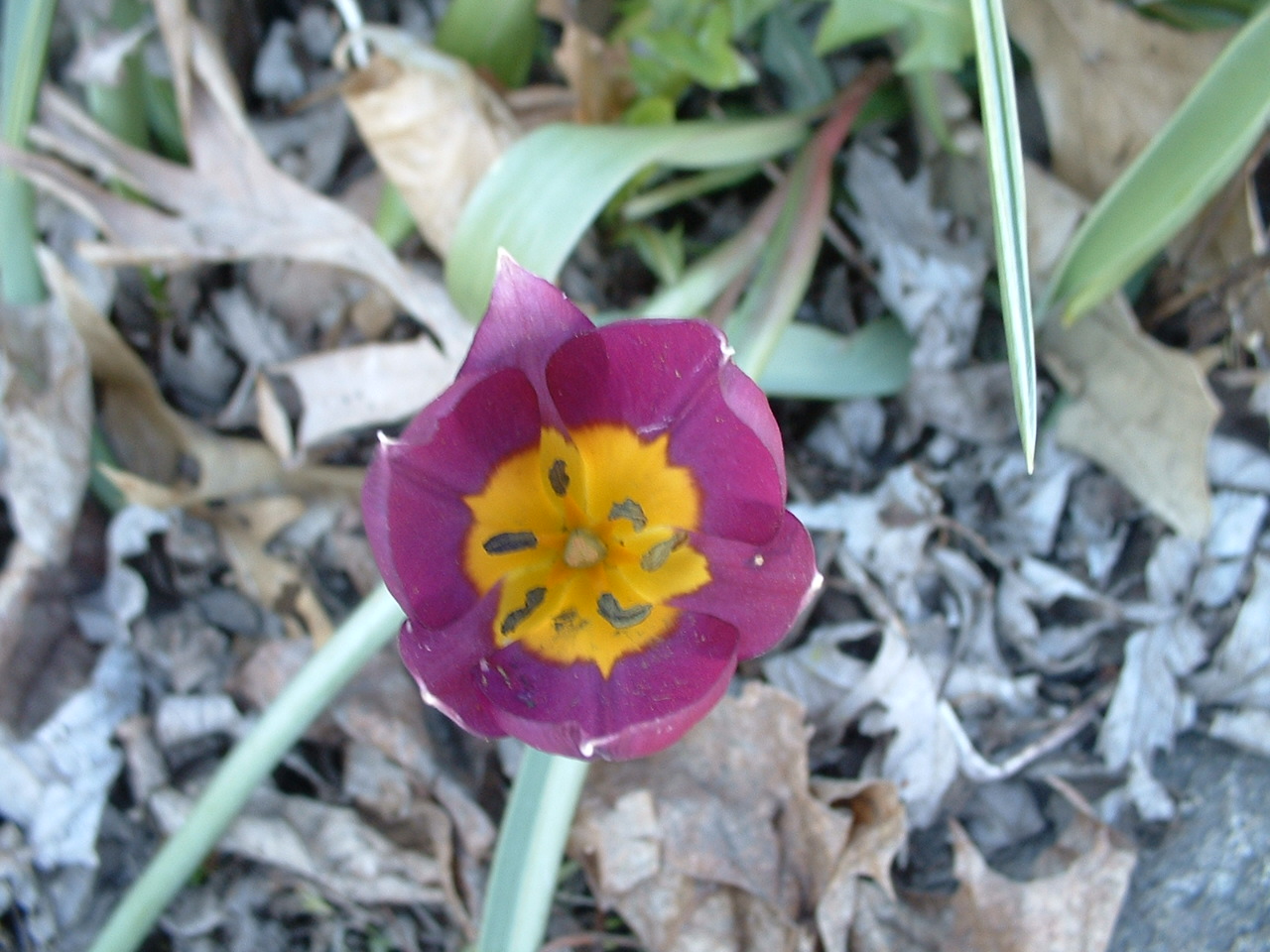 But for today ... the real tough survivors are the dwarf tulips (Tulipa, "Persian Pearl") and some of our hyacinths... these are the only ones I've seen up yet, though there are about 9 others on the north side I've not seen emerge yet. So here's what I got today ... these dwarf tulips are really fun to have in the garden, and unlike their bigger cousins, you don't have to plant them so deep it takes a shovel... and they appear to spread a bit, as I swear there are more there this year than there were last! Unfortunately, they don't last as long as the Darwins we prefer, but for sheer diminutive stopping power, these little guys are hard to beat! They're a perfect planting companion for Muscari ("Grape Hyacinths"), and also look pretty kicking with the hyacinths too! And since they all bloom at about the same time, and with a little imaginationyou could get some really interesting color combinations!
But for today ... the real tough survivors are the dwarf tulips (Tulipa, "Persian Pearl") and some of our hyacinths... these are the only ones I've seen up yet, though there are about 9 others on the north side I've not seen emerge yet. So here's what I got today ... these dwarf tulips are really fun to have in the garden, and unlike their bigger cousins, you don't have to plant them so deep it takes a shovel... and they appear to spread a bit, as I swear there are more there this year than there were last! Unfortunately, they don't last as long as the Darwins we prefer, but for sheer diminutive stopping power, these little guys are hard to beat! They're a perfect planting companion for Muscari ("Grape Hyacinths"), and also look pretty kicking with the hyacinths too! And since they all bloom at about the same time, and with a little imaginationyou could get some really interesting color combinations!
And of course, what would a tulip post be without the ubiquitous inner bits for Olivia? They may be a bit on the waning side of things, but they're alive! And that's what really is counting for us of late ...
In the next few days I'm going to be posting some of last year's spring glories (for obvious weather related reasons), so stay tuned for even more brilliant color. Olivia and I are going to be doing a joint posting soon on one of my very favorite tulips ... "Olympic Flame" so do check back soon for that in a day or so!
It looks like our Crown Imperial fritillarias may not make it this year ... but I'll keep you posted, so to speak!
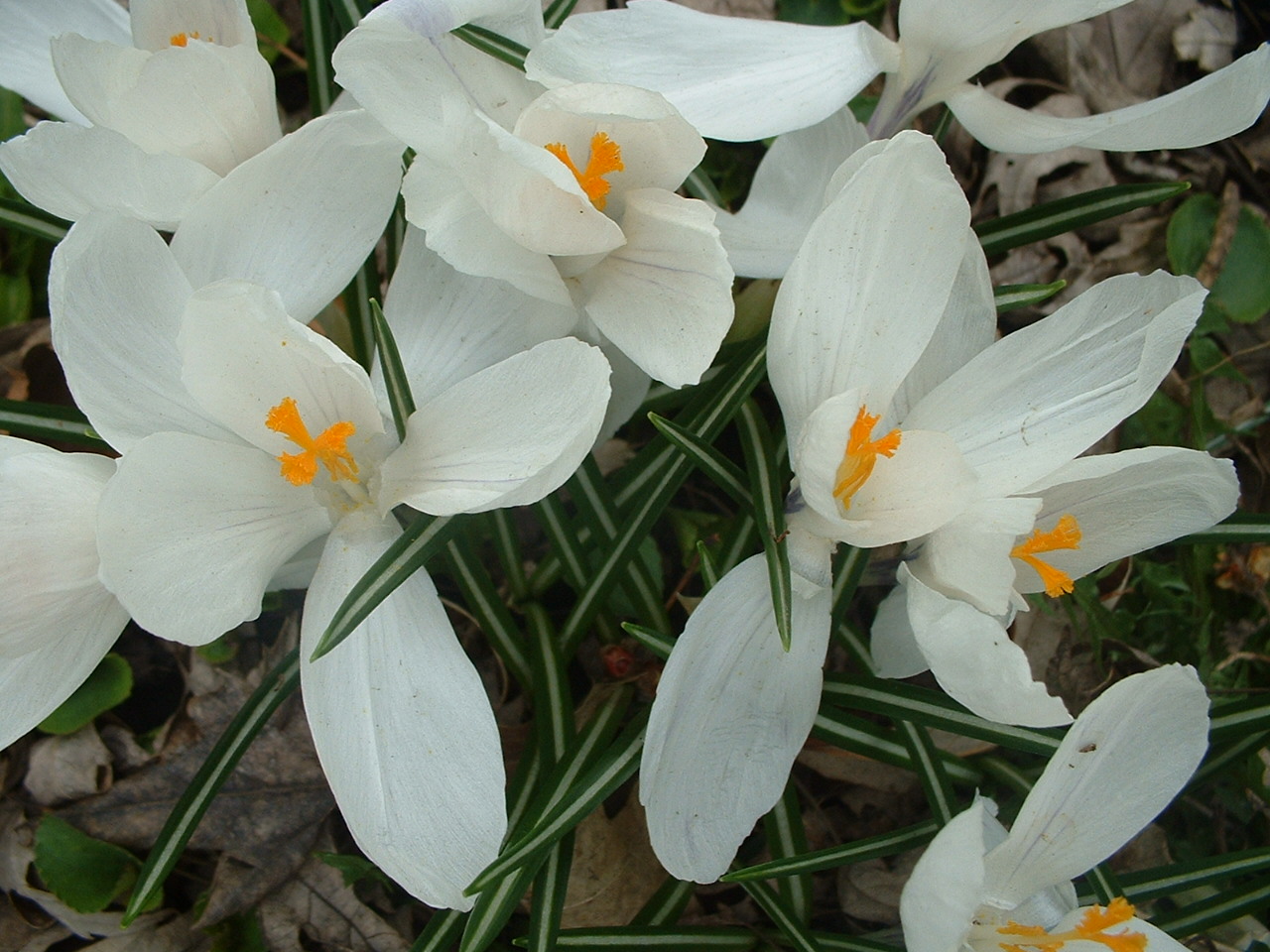 And finally, some long-promised inner crocus bits for my dear gardening cohort in Ottawa Olivia, who has been having a few bunny issues with her crocus thus far this spring.
And finally, some long-promised inner crocus bits for my dear gardening cohort in Ottawa Olivia, who has been having a few bunny issues with her crocus thus far this spring.
Though these lovely giant Dutch crocus have since departed the scene due to excessive rains and winds, they did put on a delightful show a week or so ago in the front gardens ... And though they don't last as long as the snow crocus do, the giants are truly wonderful to see thrusting their bold flowers forth when their time arrives!
So here's to Olivia ... winter can't last that much longer, and with a Bunnyvac 6000 brought on site, you may yet see the crocus grace your garden! Well, at least we can wish and dream for that, can't we?
 It's got to be a hard-hearted, cold and ruthless person who doesn't just instantly cheer up and smile when they see a mass of daffodils in bloom! And when you're looking for real bang for your buck when planting bulbs, you can never go wrong by buying as many daffodils as you can and are willing to go to the effort to plant.
It's got to be a hard-hearted, cold and ruthless person who doesn't just instantly cheer up and smile when they see a mass of daffodils in bloom! And when you're looking for real bang for your buck when planting bulbs, you can never go wrong by buying as many daffodils as you can and are willing to go to the effort to plant.
Like any of the larger spring bulbs, Daffodils need to be planted relatively deep (about 6"- 8"), so the initial planting can be a chore. But the rewards are so ample and brilliantly hued that it's all ultimately worth the effort. I'd personally recommend buying the naturalizing plain yellow varieties because they will colonize over time ... those fancier, mutant-y hybrid varieties don't bloom true for many years and eventually just revert to a strange, vulgate form of Narcissus that's really not the most attractive to have in the garden. Just our own personal flower snobbery in this regard, but if you want the true, old-fashioned forms, it's best to go with the simplest yellow, naturalizing variety you can find.
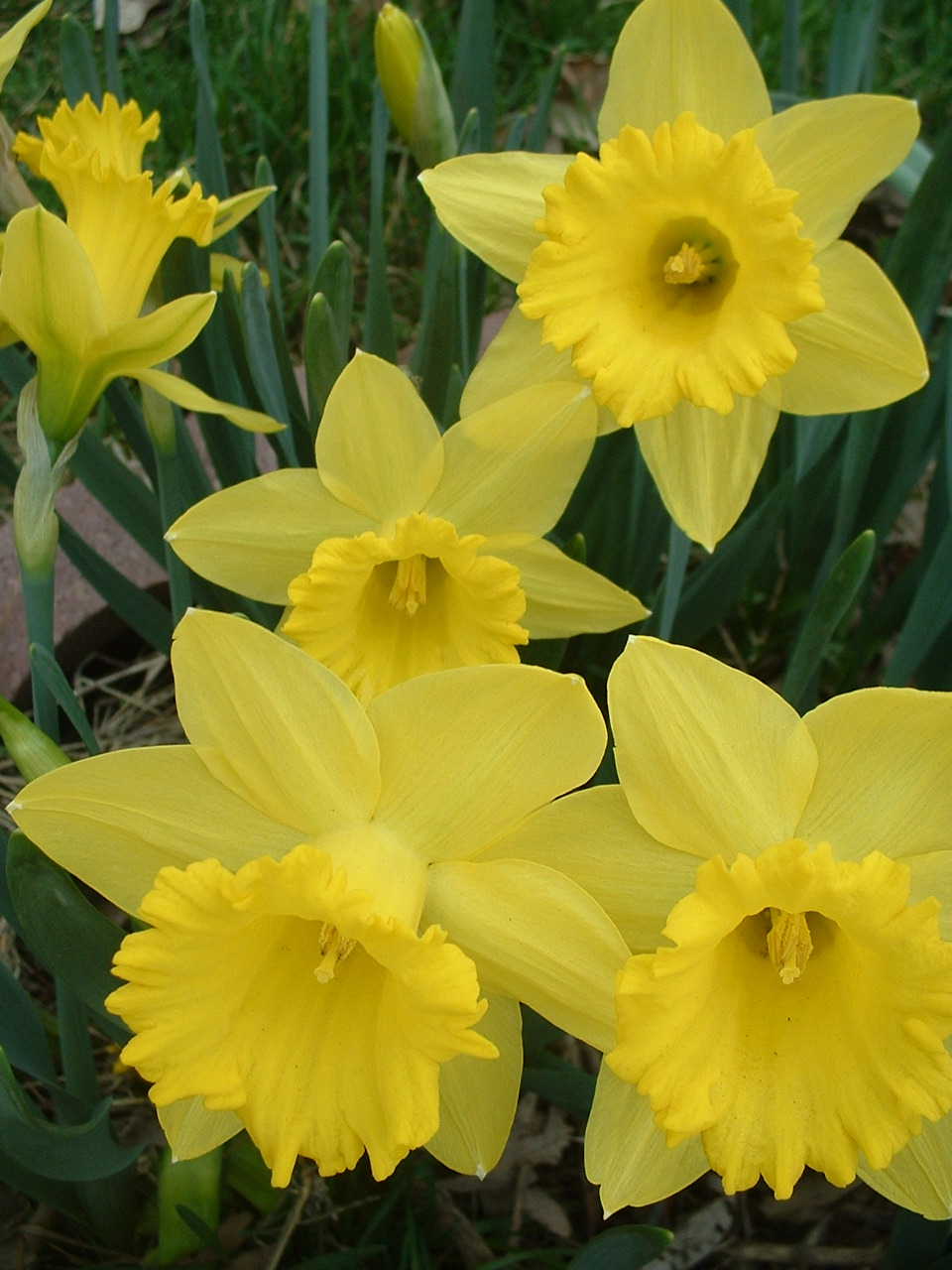 And as a side note to those who have deer problems in the garden ... Daffodils are widely known to be a deer repellant plant (one among many we seem to have instinctively planted in our garden), so they fulfill another useful garden function as well. I'm not sure what other critters they may repel, but since we have many daffodils planted among the tulips, I wonder if they also have rabbit chasing properties as well... so many here tell me that the rabbits devour their tulips in spring, yet ours remain untouched ... I may have to do some more research on that, but for now, enjoy these happy yellow faces while they last!
And as a side note to those who have deer problems in the garden ... Daffodils are widely known to be a deer repellant plant (one among many we seem to have instinctively planted in our garden), so they fulfill another useful garden function as well. I'm not sure what other critters they may repel, but since we have many daffodils planted among the tulips, I wonder if they also have rabbit chasing properties as well... so many here tell me that the rabbits devour their tulips in spring, yet ours remain untouched ... I may have to do some more research on that, but for now, enjoy these happy yellow faces while they last!
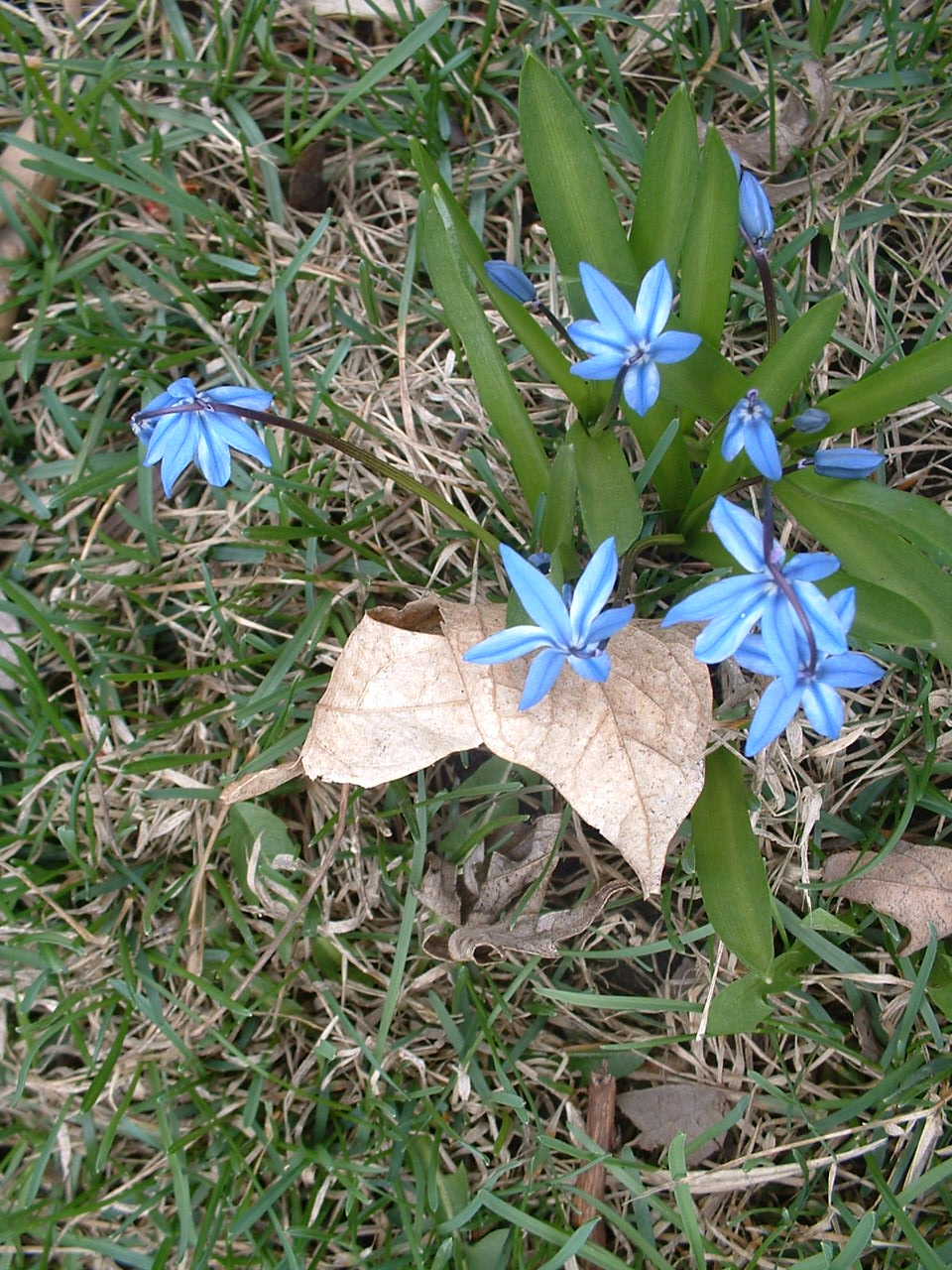 It's not always bad to have the early spring blues this time of year. Especially if said blue is provided by Siberian Squill (Scilla siberica), an absolute must have in any garden's bulb planting areas. Aside from the Snow Drops, Crocus and the Glory of the Snow (featured previously), Squill is an essential early bloomer that signals spring has truly arrived.
It's not always bad to have the early spring blues this time of year. Especially if said blue is provided by Siberian Squill (Scilla siberica), an absolute must have in any garden's bulb planting areas. Aside from the Snow Drops, Crocus and the Glory of the Snow (featured previously), Squill is an essential early bloomer that signals spring has truly arrived.
These tough little plants do indeed hail from colder climes and are hardy as far north as Zone 3 ... and they're busy colonizers when planted right down there in the lawn. If you give them a few years, they will spread out to form cheery blue clumps that will enlarge over time. And for those who prefer their bulbs virtually maintenance-free, Squilll is a perfect choice... once planted, there's nothing else to do ... they will return year after year, increasing gradually and when they're done blooming and putting on the little bulblets that help to propagate them, it's time to mow the grass and they disappear into the lawn until the following spring.
Cultivation is pretty similar to that of Crocus, Snowdrops and Glory of the Snow, in that they're smallish bulbs that don't have to go down very deep, prefer a sunny location and well drained soil. Our dream is to eventually have the parking out front carpeted in blue from Squill, much like a house we see in town where it's been established for decades.
I'll have more on the Scilla species later on this spring when our other variety Scilla hispanica aka, Wood Hyacinth blooms... it's a larger variety with more developed bloom stalks, but still in the delectable blue-violet range that makes them such welcome additions to the early spring yellows and whites ... if you're looking to expand your bulb varieties, you must consider planting Squill ... though they are not particularly cheap, they are worth the investment, if for no other reason they provide some welcome blue early on to chase away the last of winter, and they like to set up housekeeping even in a lawn planting situation....
 Though they started out this year with all odds against them, many of the tulips did make a good stand at providing an abbreviated late spring show. Dashes of bright color, amongst all the damaged daffodils and other victims of the recent freezes, they carried on in spite of it all ... I'm afraid these represent most of the better examples that managed to bloom this year ... our regular masses of yellow and red were pretty much decimated ... first by the cold and then by the recent heavy rains. And as the regular perennials start to make their presences known, it seems that the tulips were resigned to cede the show much more quickly this year, though through no fault of their own.
Though they started out this year with all odds against them, many of the tulips did make a good stand at providing an abbreviated late spring show. Dashes of bright color, amongst all the damaged daffodils and other victims of the recent freezes, they carried on in spite of it all ... I'm afraid these represent most of the better examples that managed to bloom this year ... our regular masses of yellow and red were pretty much decimated ... first by the cold and then by the recent heavy rains. And as the regular perennials start to make their presences known, it seems that the tulips were resigned to cede the show much more quickly this year, though through no fault of their own.
 planted over the years ... the orange one has been around for at least five years and the yellow one (very close to an Olympic flame type) was planted two years ago during the big bulb planting fest. I'll refrain from my usual Darwins sermon ... just remember they're the best for naturalizing!
planted over the years ... the orange one has been around for at least five years and the yellow one (very close to an Olympic flame type) was planted two years ago during the big bulb planting fest. I'll refrain from my usual Darwins sermon ... just remember they're the best for naturalizing!

































